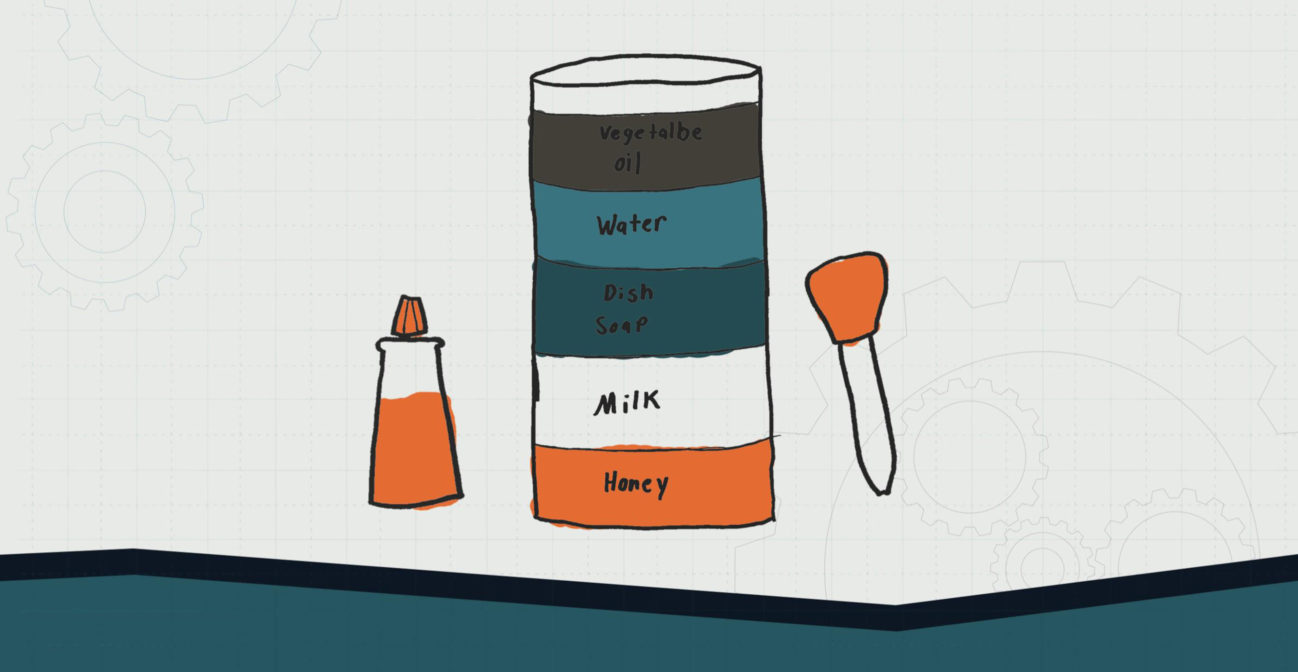Join us for conversations that inspire, recognize, and encourage innovation and best practices in the education profession.
Available on Apple Podcasts, Spotify, Google Podcasts, and more.

MIDDLE SCHOOL – LEVEL 1
Try your hand at this stackable liquid house of cards. This experiment is about fluids of various densities, studying their properties and how they interact. We will be using water-based liquids, meaning liquids made of water and other dissolved substances.
MATERIALS NEEDED:
❏ Water
❏ Food coloring
❏ Milk
❏ Honey
❏ Vegetable oil
❏ Dishwashing soap
❏ Tall glass
❏ Ping pong ball
❏ Cherry tomato
❏ Turkey baster
Try your hand at this stackable liquid house of cards. This experiment is about fluids of various densities, studying their properties and how they interact. We will be using water-based liquids, meaning made of water and and other dissolved substances.
DIRECTIONS:
Your pillar is built! Now, drop your ping pong ball on the top layer and watch, what happened? Try a cherry tomato next. Notice how different objects interact with the fluids differently.
OBJECTIVE: Students will be able to construct a density pillar and to interpret whether a new substance was formed.
ESSENTIAL QUESTION(S):
1. Perform a density demo for students using oil and water.
a. Have two containers
i. One filled with water and food coloring
ii. One filled with oil
b. Have students rotate to the front of the room and record observations of the two liquids
c. Have students make predictions on what will happen when the two substances are “mixed”
d. Pour oil on top of the water
i. Have students record observations of the substances after the are mixed
ii. Have students make conclusion based on evidence on why the oil “floats” on the water
e. Repeat the process by pouring water into the oil
i. Make sure you have students make predictions observations, and conclusions from their activity.
2. Evaluate
a. Informally students Predictions, observations, conclusions.
1. Provide students with the material list.
a. Have students observe each material independently
b. Students may record mass and volume of each substance
2. Ask students to perform experiments to determine what happens when various combinations of the substances are mixed
3. Evaluate
a. Process of data collection
b. Conclusions made from evidence
1. Students and teacher should discuss why some substances float on others
2. Review of density with students may be required
3. Review of chemical and physical changes to determine if this applies here
4. These activities should be supplemented with other chemical and physical change experiments
a. See the Middle School Level 1 project: “Water Desalination”
1. Students use their data from above to construct a density pillar
2. Use their density pillar to discuss density and that the substances do not mix because of density.
3. If substances do mix discuss if a new substance was formed or if the molecules mixed is it a new substance?
4. Evaluate
a. Students use of data to draw conclusions
b. Reasoning
NGSS CONNECTION:
MS-PS1-2. Analyze and interpret data on the properties of substances before and after thesubstances interact to determine if a chemicalreaction has occurred.
COMMON CORE CONNECTION:
ELA/Literacy
RST.6-8.1 Cite specific textual evidence to supportanalysis of science and technical texts, attendingto the precise details of explanations ordescriptions.
RST.6-8.7 Integrate quantitative or technicalinformation expressed in words in a text with aversion of that information expressed visually (e.g., in a flowchart, diagram, model, graph, or table).
Mathematics
MP.2 Reason abstractly and quantitatively.
6.RP.A.3 Use ratio and rate reasoning to solve real-world and mathematical problems.
6.SP.B.4 Display numerical data in plots on a number line, including dot plots, histograms, and box plots.
6.SP.B.5 Summarize numerical data sets in relation to their context.
DOK:
Level 1: Recall
Level 2: Concept
Level 3: Strategic Thinking